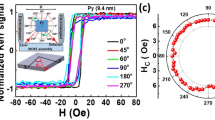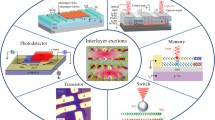Abstract
Antiferromagnets are promising components for spintronics due to their terahertz resonance, multilevel states and absence of stray fields. However, the zero net magnetic moment of antiferromagnets makes the detection of the antiferromagnetic order and the investigation of fundamental spin properties notoriously difficult. Here, we report an optical detection of Néel vector orientation through an ultra-sharp photoluminescence in the van der Waals antiferromagnet NiPS3 from bulk to atomically thin flakes. The strong correlation between spin flipping and electric dipole oscillator results in a linear polarization of the sharp emission, which aligns perpendicular to the spin orientation in the crystal. By applying an in-plane magnetic field, we achieve manipulation of the photoluminescence polarization. This correlation between emitted photons and spins in layered magnets provides routes for investigating magneto-optics in two-dimensional materials, and hence opens a path for developing opto-spintronic devices and antiferromagnet-based quantum information technologies.




Similar content being viewed by others
Data availability
Source data are provided with this paper. All other data that support results in this article are available from the corresponding authors on reasonable request.
References
Huang, B. et al. Layer-dependent ferromagnetism in a van der Waals crystal down to the monolayer limit. Nature 546, 270–273 (2017).
Gong, C. et al. Discovery of intrinsic ferromagnetism in two-dimensional van der Waals crystals. Nature 546, 265–269 (2017).
Burch, K. S., Mandrus, D. & Park, J.-G. Magnetism in two-dimensional van der Waals materials. Nature 563, 47–52 (2018).
Seyler, K. L. et al. Ligand-field helical luminescence in a 2D ferromagnetic insulator. Nat. Phys. 14, 277–281 (2018).
Němec, P., Fiebig, M., Kampfrath, T. & Kimel, A. V. Antiferromagnetic opto-spintronics. Nat. Phys. 14, 229–241 (2018).
Jungwirth, T., Marti, X., Wadley, P. & Wunderlich, J. Antiferromagnetic spintronics. Nat. Nanotechnol. 11, 231–241 (2016).
Kirilyuk, A., Kimel, A. V. & Rasing, T. Ultrafast optical manipulation of magnetic order. Rev. Mod. Phys. 82, 2731–2784 (2010).
Kampfrath, T. et al. Coherent terahertz control of antiferromagnetic spin waves. Nat. Photonics 5, 31–34 (2011).
Kriegner, D. et al. Multiple-stable anisotropic magnetoresistance memory in antiferromagnetic MnTe. Nat. Commun. 7, 11623 (2016).
Olejník, K. et al. Antiferromagnetic CuMnAs multi-level memory cell with microelectronic compatibility. Nat. Commun. 8, 15434 (2017).
Marti, X. et al. Room-temperature antiferromagnetic memory resistor. Nat. Mater. 13, 367–374 (2014).
Wadley, P. et al. Electrical switching of an antiferromagnet. Science 351, 587–590 (2016).
Wang, X. et al. Raman spectroscopy of atomically thin two-dimensional magnetic iron phosphorus trisulfide (FePS3) crystals. 2D Mater. 3, 031009 (2016).
Lee, J.-U. et al. Ising-type magnetic ordering in atomically thin FePS3. Nano Lett. 16, 7433–7438 (2016).
Kim, K. et al. Suppression of magnetic ordering in XXZ-type antiferromagnetic monolayer NiPS3. Nat. Commun. 10, 345 (2019).
Chu, H. et al. Linear magnetoelectric phase in ultrathin MnPS3 probed by optical second harmonic generation. Phys. Rev. Lett. 124, 027601 (2020).
Sun, Z. et al. Giant nonreciprocal second-harmonic generation from antiferromagnetic bilayer CrI3. Nature 572, 497–501 (2019).
Du, K. et al. Weak van der Waals stacking, wide-range band gap, and Raman study on ultrathin layers of metal phosphorus trichalcogenides. ACS Nano 10, 1738–1743 (2016).
Kuo, C.-T. et al. Exfoliation and Raman spectroscopic fingerprint of few-layer NiPS3 van der Waals crystals. Sci. Rep. 6, 20904 (2016).
Wildes, A. R. et al. Magnetic structure of the quasi-two-dimensional antiferromagnet NiPS3. Phys. Rev. B 92, 224408 (2015).
Piacentini, M., Khumalo, F. S., Olson, C. G., Anderegg, J. W. & Lynch, D. W. Optical transitions, XPS, electronic states in NiPS3. Chem. Phys. 65, 289–304 (1982).
Liu, X. & Hersam, M. C. 2D materials for quantum information science. Nat. Rev. Mater. 4, 669–684 (2019).
Schmidt, T., Lischka, K. & Zulehner, W. Excitation-power dependence of the near-band-edge photoluminescence of semiconductors. Phys. Rev. B 45, 8989–8994 (1992).
Gao, W. B., Fallahi, P., Togan, E., Miguel-Sanchez, J. & Imamoglu, A. Observation of entanglement between a quantum dot spin and a single photon. Nature 491, 426–430 (2012).
Jungwirth, N. R. & Fuchs, G. D. Optical absorption and emission mechanisms of single defects in hexagonal boron nitride. Phys. Rev. Lett. 119, 057401 (2017).
Tonndorf, P. et al. Single-photon emitters in GaSe. 2D Mater. 4, 021010 (2017).
Kang, S. et al. Coherent many-body exciton in van der Waals antiferromagnet NiPS3. Nature 583, 785–789 (2020).
Zhang, F. C. & Rice, T. M. Effective Hamiltonian for the superconducting Cu oxides. Phys. Rev. B 37, 3759–3761 (1988).
Ferre, J. & Gehring, G. A. Linear optical birefringence of magnetic crystals. Rep. Prog. Phys. 47, 513–611 (1984).
Bramwell, S. T. & Holdsworth, P. C. W. Magnetization and universal sub-critical behaviour in two-dimensional XY magnets. J. Phys. Condens. Matter 5, L53–L59 (1993).
Bramwell, S. T., Day, P., Hutchings, M. T., Thorne, J. R. G. & Visser, D. Neutron scattering and optical study of the magnetic properties of the two-dimensional ionic rubidium chromium bromide chloride ferromagnets Rb2CrCl3Br and Rb2CrCl2Br2. Inorg. Chem. 25, 417–421 (1986).
Tesařová, N. et al. Systematic study of magnetic linear dichroism and birefringence in (Ga,Mn)As. Phys. Rev. B 89, 085203 (2014).
Saidl, V. et al. Optical determination of the Néel vector in a CuMnAs thin-film antiferromagnet. Nat. Photon. 11, 91–96 (2017).
Chittari, B. L. et al. Electronic and magnetic properties of single-layer MPX3 metal phosphorous trichalcogenides. Phys. Rev. B 94, 184428 (2016).
Long, G. et al. Persistence of magnetism in atomically thin MnPS3 crystals. Nano Lett. 20, 2452–2459 (2020).
Kimel, A. V. et al. Ultrafast non-thermal control of magnetization by instantaneous photomagnetic pulses. Nature 435, 655–657 (2005).
Kresse, G. & Hafner, J. Ab initio molecular dynamics for liquid metals. Phys. Rev. B 47, 558–561 (1993).
Kresse, G. & Hafner, J. Ab initio molecular-dynamics simulation of the liquid-metal–amorphous-semiconductor transition in germanium. Phys. Rev. B 49, 14251–14269 (1994).
Kresse, G. & Furthmüller, J. Efficiency of ab-initio total energy calculations for metals and semiconductors using a plane-wave basis set. Comput. Mater. Sci. 6, 15–50 (1996).
Kresse, G. & Furthmüller, J. Efficient iterative schemes for ab initio total-energy calculations using a plane-wave basis set. Phys. Rev. B 54, 11169–11186 (1996).
Kim, S. Y. et al. Charge-spin correlation in van der Waals antiferromagnet NiPS3. Phys. Rev. Lett. 120, 136402 (2018).
Dudarev, S. L., Botton, G. A., Savrasov, S. Y., Humphreys, C. J. & Sutton, A. P. Electron-energy-loss spectra and the structural stability of nickel oxide: an LSDA+U study. Phys. Rev. B 57, 1505–1509 (1998).
Kresse, G. & Hafner, J. Norm-conserving and ultrasoft pseudopotentials for first-row and transition elements. J. Phys. Condens. Matter 6, 8245–8257 (1994).
Kresse, G. & Joubert, D. From ultrasoft pseudopotentials to the projector augmented-wave method. Phys. Rev. B 59, 1758–1775 (1999).
Kurita, N. & Nakao, K. Band structure of magnetic layered semiconductor NiPS3. J. Phys. Soc. Jpn 58, 232–243 (1989
Setyawan, W. & Curtarolo, S. High-Throughput Electronic Band StructureCalculations: Challenges and Tools. Comput. Mater. Sci. 49, 299–312, (2010).
Steiner, S. et al. Calculation of the Magnetic Anisotropy with Projected-AugmentedWave Methodology and the Case Study of Disordered Fe1−xCox Alloys. Phys. Rev. B 93, 224425, (2016).
Acknowledgements
This material is based upon work supported by the National Science Foundation under grant no. 1945364. X.W. and X.L. acknowledge the financial support from Boston University and the Photonics Center at Boston University. The transmission electron microscopy imaging was performed at the Center for Nanoscale Systems, a member of the National Nanotechnology Coordinated Infrastructure Network, which is supported by the National Science Foundation under award no. 1541959. The Center for Nanoscale Systems is part of Harvard University. A.C. and S.S. acknowledge financial support from the US Department of Energy, Office of Science, Basic Energy Sciences Early Career Program under award no. DE-SC0018080. We acknowledge the computational resources through the Extreme Science and Engineering Discovery Environment, which is supported by National Science Foundation grant no. ACI-1548562; and the National Energy Research Scientific Computing Center, a US Department of Energy Office of Science User Facility supported by the Office of Science of the US Department of Energy under contract no. DE-AC02-05CH11231. Z.L. and D.S. acknowledge support from the US Department of Energy (no. DE-FG02-07ER46451) for high-field magnetospectroscopy measurements performed at National High Magnetic Field Laboratory, which is supported by the National Science Foundation through NSF/DMR-1644779 and the state of Florida. C.H.L. acknowledges support from the American Chemical Society Petroleum Research Fund (ACS PRF No. 61640-ND6).
Author information
Authors and Affiliations
Contributions
X.W. and X.L. conceived the experiment. X.W. carried out PL and absorption measurements. X.W., J.C. and Z.L. conducted the magneto-PL measurements with assistance from D.S. at the National High Magnetic Field Laboratory. J.C. and X.W. prepared samples. J.C., H.K., T.L. and Q.T. carried out the sample characterization. A.C. and S.S. performed theoretical calculations. M.W. performed the time-resolved PL measurement under the supervision of C.H.L.; X.W. and X.L. performed the analysis and interpretation of the data. All authors assisted in the interpretation of data and contributed to the writing of the manuscript.
Corresponding authors
Ethics declarations
Competing interests
The authors declare no competing interests.
Additional information
Peer review information Nature Materials thanks the anonymous reviewers for their contribution to the peer review of this work.
Publisher’s note Springer Nature remains neutral with regard to jurisdictional claims in published maps and institutional affiliations.
Supplementary information
Supplementary Information
Supplementary Figs. 1–10 and Discussion.
Source data
Source Data Fig. 1
Source data.
Source Data Fig. 2
Source data.
Source Data Fig. 3
Source data.
Source Data Fig. 4
Source data.
Rights and permissions
About this article
Cite this article
Wang, X., Cao, J., Lu, Z. et al. Spin-induced linear polarization of photoluminescence in antiferromagnetic van der Waals crystals. Nat. Mater. 20, 964–970 (2021). https://doi.org/10.1038/s41563-021-00968-7
Received:
Accepted:
Published:
Issue Date:
DOI: https://doi.org/10.1038/s41563-021-00968-7
- Springer Nature Limited
This article is cited by
-
Magnetically propagating Hund’s exciton in van der Waals antiferromagnet NiPS3
Nature Communications (2024)
-
Proximity-induced chiral quantum light generation in strain-engineered WSe2/NiPS3 heterostructures
Nature Materials (2023)
-
Magnetic proximity boosts chiral quantum emission
Nature Materials (2023)
-
Magnetically-dressed CrSBr exciton-polaritons in ultrastrong coupling regime
Nature Communications (2023)
-
Exciton-coupled coherent magnons in a 2D semiconductor
Nature (2022)





